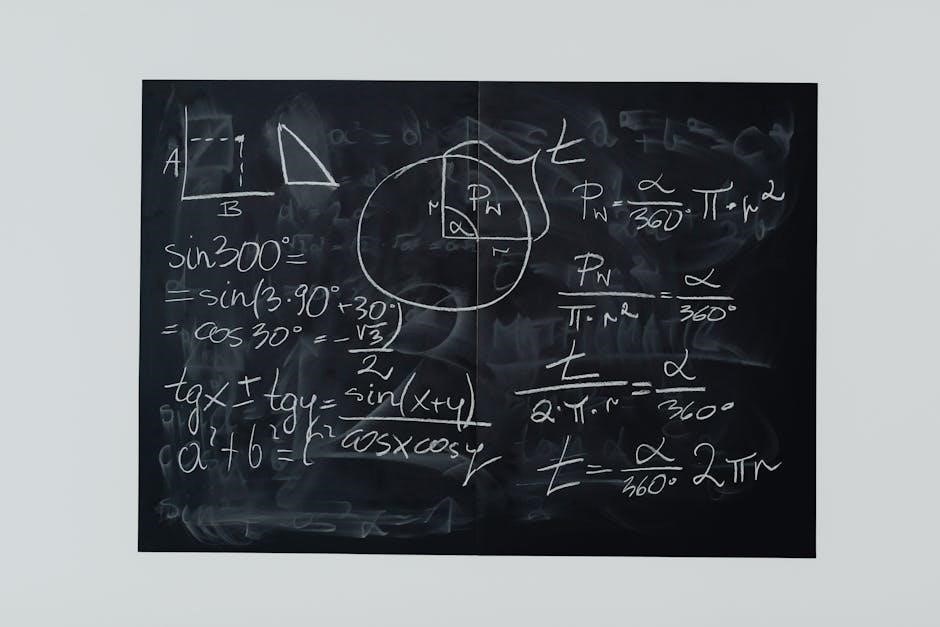Precalculus Questions and Answers PDF: A Comprehensive Guide
This guide offers a compilation of precalculus questions and their solutions‚ conveniently packaged in PDF format. It serves as a valuable resource for students seeking to reinforce their understanding and enhance problem-solving skills. Practice problems with detailed solutions are included.
Precalculus lays the groundwork for calculus by bridging the gap between algebra and more advanced mathematical topics. It encompasses a range of fundamental concepts‚ including functions‚ trigonometry‚ analytic geometry‚ and exponential and logarithmic functions. Mastering these concepts is crucial for success in calculus and other STEM fields.
Understanding functions is central to precalculus. Students learn to define‚ graph‚ and analyze various types of functions‚ including linear‚ quadratic‚ polynomial‚ rational‚ and piecewise functions. Trigonometry introduces the relationships between angles and sides of triangles‚ leading to the study of trigonometric functions and their applications. Analytic geometry connects algebra and geometry through the use of coordinate systems‚ enabling the study of conic sections and other geometric shapes. Exponential and logarithmic functions are explored for their properties and applications in modeling growth and decay phenomena.
Precalculus also emphasizes the development of problem-solving skills. Students are challenged to apply their knowledge to solve a variety of problems‚ ranging from algebraic manipulations to geometric constructions and trigonometric identities. A strong foundation in precalculus concepts is essential for tackling the challenges of calculus and beyond.
Types of Precalculus Problems
Precalculus problems are diverse‚ encompassing a wide spectrum of mathematical concepts and techniques. Algebraic problems often involve simplifying expressions‚ solving equations and inequalities‚ and working with polynomials and rational functions. Graphical problems require students to interpret and analyze graphs of functions‚ including identifying key features such as intercepts‚ asymptotes‚ and domain and range.
Trigonometric problems focus on applying trigonometric identities‚ solving trigonometric equations‚ and working with trigonometric functions in various contexts. Analytic geometry problems involve conic sections‚ parametric equations‚ and polar coordinates. Exponential and logarithmic problems require students to solve exponential and logarithmic equations‚ model growth and decay‚ and analyze exponential and logarithmic functions.
Word problems are also common in precalculus‚ requiring students to translate real-world scenarios into mathematical models and solve them using precalculus techniques. These problems often involve optimization‚ related rates‚ and other applications of precalculus concepts. Success in precalculus requires a solid understanding of these different types of problems and the ability to apply appropriate techniques to solve them.
Algebraic Techniques in Precalculus
Algebraic techniques form the foundation of precalculus problem-solving. Factoring polynomials is crucial for simplifying expressions and solving equations. Proficiency in manipulating exponents and radicals is essential for working with various types of functions. Solving equations‚ including linear‚ quadratic‚ rational‚ and radical equations‚ is a fundamental skill.
Understanding and applying the properties of inequalities is necessary for solving inequalities and analyzing function behavior. Working with functions‚ including function composition‚ inverse functions‚ and transformations‚ requires a solid grasp of algebraic concepts. Knowledge of sequences and series‚ including arithmetic and geometric sequences‚ is also important.

Additionally‚ students must be adept at using algebraic techniques to model real-world scenarios and solve applied problems. Mastery of these algebraic techniques enables students to approach precalculus problems with confidence and precision. These techniques provide the tools necessary to manipulate expressions‚ solve equations‚ and analyze functions effectively‚ laying the groundwork for success in calculus and beyond.
Graphical Solutions in Precalculus
Graphical solutions provide a visual approach to understanding and solving precalculus problems. Graphing functions is crucial for visualizing their behavior and properties. Identifying key features of graphs‚ such as intercepts‚ maxima‚ minima‚ and asymptotes‚ is essential for analysis. Utilizing graphs to solve equations and inequalities offers an alternative method to algebraic techniques.
Understanding transformations of graphs‚ including shifts‚ stretches‚ and reflections‚ allows for the manipulation and interpretation of functions. Graphing trigonometric functions and analyzing their periodic behavior is a significant aspect of precalculus; Using technology‚ such as graphing calculators or software‚ can aid in visualizing complex functions and finding approximate solutions.
Interpreting graphs in real-world contexts enables students to apply precalculus concepts to practical situations. Constructing graphs from given information‚ such as data points or equations‚ demonstrates a strong understanding of graphical relationships. Graphical solutions offer a complementary perspective to algebraic methods‚ enhancing problem-solving skills and providing a deeper understanding of precalculus concepts. This approach fosters visual intuition and reinforces analytical thinking.
Trigonometric Problems and Solutions
Trigonometry forms a cornerstone of precalculus‚ focusing on the relationships between angles and sides of triangles. Solving trigonometric equations involves finding values that satisfy given equations using identities and algebraic manipulation. Applying trigonometric identities simplifies complex expressions and aids in solving equations. Understanding the unit circle is crucial for determining trigonometric values of various angles.
Solving right triangle problems involves using trigonometric ratios (sine‚ cosine‚ tangent) to find unknown sides and angles. Working with inverse trigonometric functions allows for finding angles corresponding to given trigonometric values. Analyzing trigonometric graphs‚ including amplitude‚ period‚ and phase shift‚ is essential for understanding their behavior. Solving oblique triangles uses the Law of Sines and the Law of Cosines.
Applications of trigonometry in real-world scenarios‚ such as navigation and surveying‚ demonstrate its practical significance. Verifying trigonometric identities requires strategic manipulation of expressions using known identities. Solving word problems involving angles of elevation and depression applies trigonometric concepts to practical situations. Mastering trigonometric problems and solutions is vital for success in calculus and related fields‚ providing a strong foundation for advanced mathematical concepts.
Linear Equations and Their Applications

Linear equations are fundamental to precalculus‚ representing straight lines on a graph. Solving linear equations involves finding the value(s) of the variable that make the equation true‚ often using algebraic manipulation. Understanding slope-intercept form (y = mx + b) is crucial for graphing and analyzing linear equations‚ where ‘m’ represents the slope and ‘b’ the y-intercept.
Finding the equation of a line given two points or a point and a slope is a common task‚ utilizing the point-slope form or slope-intercept form. Parallel lines have equal slopes‚ while perpendicular lines have slopes that are negative reciprocals of each other. Applications of linear equations span various fields;
Modeling real-world scenarios with linear equations allows for predicting trends and making informed decisions. Solving systems of linear equations‚ using methods like substitution or elimination‚ finds the intersection point of multiple lines. Linear inequalities represent regions on a graph‚ and their solutions involve shading the appropriate area. Understanding linear equations and their applications forms a basis for more advanced topics in mathematics‚ providing a practical tool for problem-solving across disciplines.
Domain and Range Determination
Determining the domain and range of a function is a core concept in precalculus‚ essential for understanding its behavior. The domain represents all possible input values (x-values) for which the function is defined‚ while the range represents all possible output values (y-values) that the function can produce. Identifying restrictions on the domain is crucial‚ considering factors like division by zero‚ square roots of negative numbers‚ and logarithms of non-positive numbers.
Interval notation is commonly used to express the domain and range‚ providing a concise way to represent sets of numbers. Graphical analysis plays a significant role‚ where the domain can be visualized as the projection of the function’s graph onto the x-axis‚ and the range as the projection onto the y-axis. Understanding parent functions and their transformations aids in determining the domain and range of more complex functions.
Real-world applications often impose limitations on the domain and range‚ reflecting physical constraints or practical considerations. Recognizing these limitations is vital for interpreting the function’s behavior within a specific context. Mastering domain and range determination is fundamental for analyzing functions‚ solving equations‚ and understanding their applications in various fields‚ setting a foundation for further study in calculus.
Solving Equations and Inequalities

Solving equations and inequalities forms a cornerstone of precalculus‚ demanding a strong grasp of algebraic manipulation and logical reasoning. Equations involve finding the values of variables that satisfy a given equality‚ while inequalities aim to identify the range of values that fulfill a specific relationship. Linear equations‚ quadratic equations‚ and rational equations are common types encountered‚ each requiring tailored solution techniques.
Factoring‚ using the quadratic formula‚ and employing properties of equality are essential tools for solving equations. When dealing with inequalities‚ it’s crucial to consider the direction of the inequality sign and the impact of multiplying or dividing by negative numbers. Interval notation is widely used to express the solution sets of inequalities‚ providing a clear representation of the range of values.
Graphical methods offer a visual approach to solving equations and inequalities‚ where the solutions correspond to the points of intersection or the regions where the graph satisfies the given condition. Absolute value equations and inequalities introduce additional complexities‚ requiring careful consideration of different cases. Proficiency in solving equations and inequalities is fundamental for tackling more advanced topics in precalculus and calculus‚ enabling the analysis and modeling of real-world phenomena.
Practice Problems with Detailed Solutions
Mastering precalculus concepts requires consistent practice‚ and this section offers a wealth of practice problems accompanied by detailed solutions. These problems cover a wide range of topics‚ including algebraic techniques‚ graphical analysis‚ trigonometric functions‚ and equation solving. Each problem is carefully crafted to challenge your understanding and encourage critical thinking.
The detailed solutions provide step-by-step explanations‚ guiding you through the problem-solving process and highlighting key concepts and strategies. By working through these problems‚ you can reinforce your knowledge‚ identify areas for improvement‚ and develop your problem-solving skills. The variety of problems ensures that you are well-prepared for exams and future coursework.
Whether you are struggling with a specific concept or simply seeking to enhance your understanding‚ these practice problems and solutions offer a valuable resource. By actively engaging with the material and carefully reviewing the solutions‚ you can build a solid foundation in precalculus and gain the confidence to tackle more challenging problems. Remember‚ practice makes perfect‚ and this section provides ample opportunities to hone your skills and achieve success in precalculus.
Resources for Precalculus Learning
Embarking on the journey of precalculus learning can be greatly enhanced by leveraging the wealth of resources available. This section highlights a variety of valuable tools and materials to support your studies and deepen your understanding of the subject matter. From textbooks and online platforms to video tutorials and practice problems‚ these resources cater to diverse learning styles and preferences.
Textbooks provide a comprehensive foundation in precalculus concepts‚ offering detailed explanations‚ examples‚ and exercises. Online platforms offer interactive lessons‚ practice quizzes‚ and personalized feedback. Video tutorials provide visual explanations of key concepts and problem-solving techniques. Practice problems‚ such as those found in a precalculus questions and answers PDF‚ allow you to test your knowledge and refine your skills.

In addition to these core resources‚ consider exploring supplementary materials such as study guides‚ solution manuals‚ and online forums. Collaboration with peers and guidance from instructors can also significantly contribute to your learning journey. By strategically utilizing these resources‚ you can create a personalized learning plan that maximizes your understanding and success in precalculus. Remember‚ learning is an active process‚ so engage with the material‚ ask questions‚ and seek help when needed.
